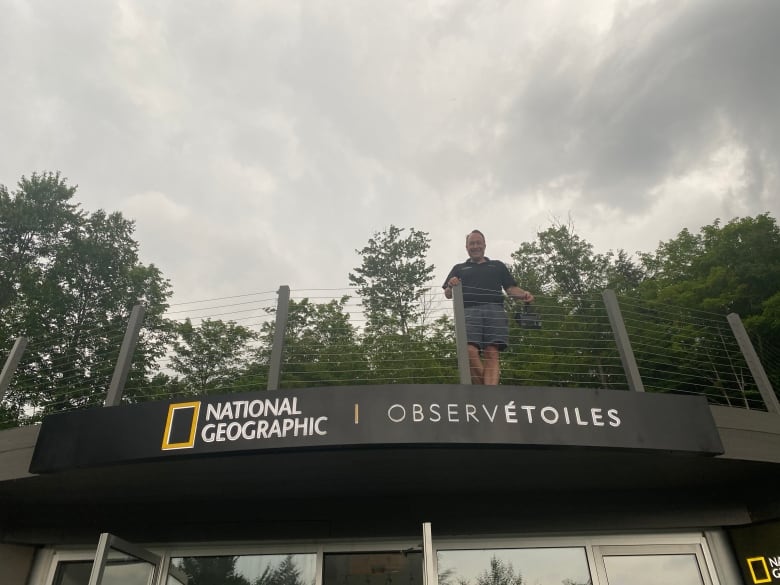
Nestled deep in the forest in the Eastern Townships, perched on the side of a mountain, there’s a 184-seat Roman-style amphitheatre, where dozens of people have waited for the sun to set and for total darkness to arrive, to don specially-made augmented reality headsets, and stare into the night sky.
Au Diable Vert, an outdoor recreation outfitter in the Sutton mountain range, has developed the world’s first augmented reality planetarium experience, called Observétoiles.
The headsets — made of cardboard, with straps to keep them secure, and outfitted with a smartphone and special app — allow people to look up at the sky and identify the stars, planets and constellations.
Observétoiles’s hour-long presentation by an astronomer takes participants on a tour of the solar system, before identifying the dozens of constellations and talking about their Indigenous, Asian, and Greco-Roman histories.
The app and headset superimpose faint images, the original 17th century illustrations of 88 constellations, over the real stars in the sky, depending on where you face.
And the amphitheatre has heated seats.
“It’s pretty amazing,” said Au Diable Vert owner Jeremy Fontana, whose idea it was to capitalize on the near-total darkness on the mountain, where he says stargazing has always been spectacular.

“You know one of the best things about being at Au Diable Vert is the location,” he said, pointing across the valley at Jay Peak, just a few kilometres away as the crow flies, in Vermont.
“You’ll see as the sun goes down, there is not one single light, there’s not even one light bulb, which is not so unusual in Quebec, but it’s very unusual an hour and a half from Montreal, and an hour from Sherbrooke,” he said. “That’s one of the most compelling things about the site.”
Years of research, a dozen ideas
Before there was Observétoiles, Fontana said he bounced around several ideas for how to get the best outdoor planetarium experience.
He said when he bought the place 15 years ago, visitors would tell him about the shooting stars and satellites they’d seen, not to mention Jupiter and Saturn.
Fontana decided to try using a telescope.
“There are some things you can see with a small telescope,” he said, but it had its challenges, since guests would often bump the telescopes, which would then have to be reset.
“The moon looks cool, you can often see the rings around Saturn, you can see quasars, which just kind of look like dust on the lens, so I said to my wife that there has to be a better way.”

Fontana imagined creating heated boxes for people to sit and stargaze during the winter, or a massive glamping dome big enough for everyone to sit inside and look up, or even projecting the images of the constellations onto the sky using a giant laser. But none of the ideas were perfect.
The business owner then thought of augmented reality.
He travelled to a conference to find the perfect headset, and purchased 10,000 of them from a kickstarter in the Netherlands that adapted the product to Fontana’s needs — namely being able to use it at night.
“As you look at the sky, the image of the constellation appears where it should be right over those real stars, and as you move around, the constellations change,” he explained.
“And if you look down at the ground, you actually see the constellations that are in Australia, which is super weird and super fun,” he said. “The phone doesn’t really know, it just knows that if you look that way, those are the stars and the constellations.”

Fontana later contacted National Geographic, which got on board with the project, and he worked with the municipality of Sutton to use narrower beam LED lights in town to reduce light pollution, and Au Diable Vert became a dark sky preservation zone.
“It’s been a big adventure,” Fontana said.
From the amphitheatre, people can see dozens of satellites, and on most nights, the Milky Way shines bright and looks almost 3D.
“It really is an astoundingly dark sky, which is amazing,” Fontana said.
Participants Eric Fournier and Andreane Asselin said they heard about Observétoiles online and decided to stay at Au Diable Vert for a few nights.
“The stars showed up,” Fournier said.
“It was better [than expected],” he said. “It was really the presentation that made a big difference.”
Finding the right staff
Fournier said an unexpected hurdle was finding astronomers who would be willing to give the presentations.
“I posted it, and I thought I was going to be flooded, but I was having a very hard time,” he said, explaining he tried to recruit staff at university space programs.
“I spoke to someone who told me astronomers don’t know anything about stars and constellations,” he said.
“They study quasars, and black holes and the time continuum, and they study them in super detail, and just because they’re working in the sky all the time doesn’t mean they know the history of the constellations and the First Nations and the stories.”
Once the technology was up and running, Fontana said he was lucky to find amateur astronomers who knew all about the planets and the constellations, and they were able to put a presentation together.

Edu-tainment
“Once you do something a couple times even as a guest, once you use the headset a few times, you know when you’re in your backyard at 9 or 10 o’clock, you’ll be able to see those constellations without the headset, so it’s really a learning activity, edu-tainment, if you will,” Fontana said.
“It’s been satisfying to see it come together, and it’s fun to have something local be recognized in so many other places,” he added.
Sophie Chagnon has been working at Au Diable Vert for the better part of a decade, first as a summer student, and then full time during the summers.
“It’s been really exciting and quite interesting to learn about the stars I’ve seen my whole life,” she said.
Chagnon said every year there’s a new fact she learns that sticks with her, such as the days of the week being named after the planets in our solar system.
Fontana said the team’s been fortunate that Observétoiles is in many ways a post-COVID-19 idea, where participants can be distanced and outside in the fresh air.












